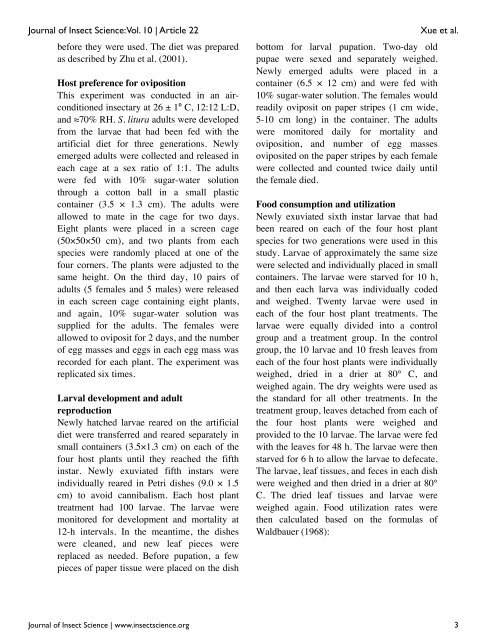Effects of four host plants on biology and food utilization - Journal of ...
Effects of four host plants on biology and food utilization - Journal of ...
Effects of four host plants on biology and food utilization - Journal of ...
You also want an ePaper? Increase the reach of your titles
YUMPU automatically turns print PDFs into web optimized ePapers that Google loves.
<strong>Journal</strong> <str<strong>on</strong>g>of</str<strong>on</strong>g> Insect Science: Vol. 10 | Article 22<br />
before they were used. The diet was prepared<br />
as described by Zhu et al. (2001).<br />
Host preference for ovipositi<strong>on</strong><br />
This experiment was c<strong>on</strong>ducted in an airc<strong>on</strong>diti<strong>on</strong>ed<br />
insectary at 26 ± 1⁰ C, 12:12 L:D,<br />
<strong>and</strong> ≈70% RH. S. litura adults were developed<br />
from the larvae that had been fed with the<br />
artificial diet for three generati<strong>on</strong>s. Newly<br />
emerged adults were collected <strong>and</strong> released in<br />
each cage at a sex ratio <str<strong>on</strong>g>of</str<strong>on</strong>g> 1:1. The adults<br />
were fed with 10% sugar-water soluti<strong>on</strong><br />
through a cott<strong>on</strong> ball in a small plastic<br />
c<strong>on</strong>tainer (3.5 × 1.3 cm). The adults were<br />
allowed to mate in the cage for two days.<br />
Eight <str<strong>on</strong>g>plants</str<strong>on</strong>g> were placed in a screen cage<br />
(50×50×50 cm), <strong>and</strong> two <str<strong>on</strong>g>plants</str<strong>on</strong>g> from each<br />
species were r<strong>and</strong>omly placed at <strong>on</strong>e <str<strong>on</strong>g>of</str<strong>on</strong>g> the<br />
<str<strong>on</strong>g>four</str<strong>on</strong>g> corners. The <str<strong>on</strong>g>plants</str<strong>on</strong>g> were adjusted to the<br />
same height. On the third day, 10 pairs <str<strong>on</strong>g>of</str<strong>on</strong>g><br />
adults (5 females <strong>and</strong> 5 males) were released<br />
in each screen cage c<strong>on</strong>taining eight <str<strong>on</strong>g>plants</str<strong>on</strong>g>,<br />
<strong>and</strong> again, 10% sugar-water soluti<strong>on</strong> was<br />
supplied for the adults. The females were<br />
allowed to oviposit for 2 days, <strong>and</strong> the number<br />
<str<strong>on</strong>g>of</str<strong>on</strong>g> egg masses <strong>and</strong> eggs in each egg mass was<br />
recorded for each plant. The experiment was<br />
replicated six times.<br />
Larval development <strong>and</strong> adult<br />
reproducti<strong>on</strong><br />
Newly hatched larvae reared <strong>on</strong> the artificial<br />
diet were transferred <strong>and</strong> reared separately in<br />
small c<strong>on</strong>tainers (3.5×1.3 cm) <strong>on</strong> each <str<strong>on</strong>g>of</str<strong>on</strong>g> the<br />
<str<strong>on</strong>g>four</str<strong>on</strong>g> <str<strong>on</strong>g>host</str<strong>on</strong>g> <str<strong>on</strong>g>plants</str<strong>on</strong>g> until they reached the fifth<br />
instar. Newly exuviated fifth instars were<br />
individually reared in Petri dishes (9.0 × 1.5<br />
cm) to avoid cannibalism. Each <str<strong>on</strong>g>host</str<strong>on</strong>g> plant<br />
treatment had 100 larvae. The larvae were<br />
m<strong>on</strong>itored for development <strong>and</strong> mortality at<br />
12-h intervals. In the meantime, the dishes<br />
were cleaned, <strong>and</strong> new leaf pieces were<br />
replaced as needed. Before pupati<strong>on</strong>, a few<br />
pieces <str<strong>on</strong>g>of</str<strong>on</strong>g> paper tissue were placed <strong>on</strong> the dish<br />
bottom for larval pupati<strong>on</strong>. Two-day old<br />
pupae were sexed <strong>and</strong> separately weighed.<br />
Newly emerged adults were placed in a<br />
c<strong>on</strong>tainer (6.5 × 12 cm) <strong>and</strong> were fed with<br />
10% sugar-water soluti<strong>on</strong>. The females would<br />
readily oviposit <strong>on</strong> paper stripes (1 cm wide,<br />
5-10 cm l<strong>on</strong>g) in the c<strong>on</strong>tainer. The adults<br />
were m<strong>on</strong>itored daily for mortality <strong>and</strong><br />
ovipositi<strong>on</strong>, <strong>and</strong> number <str<strong>on</strong>g>of</str<strong>on</strong>g> egg masses<br />
oviposited <strong>on</strong> the paper stripes by each female<br />
were collected <strong>and</strong> counted twice daily until<br />
the female died.<br />
Food c<strong>on</strong>sumpti<strong>on</strong> <strong>and</strong> utilizati<strong>on</strong><br />
Newly exuviated sixth instar larvae that had<br />
been reared <strong>on</strong> each <str<strong>on</strong>g>of</str<strong>on</strong>g> the <str<strong>on</strong>g>four</str<strong>on</strong>g> <str<strong>on</strong>g>host</str<strong>on</strong>g> plant<br />
species for two generati<strong>on</strong>s were used in this<br />
study. Larvae <str<strong>on</strong>g>of</str<strong>on</strong>g> approximately the same size<br />
were selected <strong>and</strong> individually placed in small<br />
c<strong>on</strong>tainers. The larvae were starved for 10 h,<br />
<strong>and</strong> then each larva was individually coded<br />
<strong>and</strong> weighed. Twenty larvae were used in<br />
each <str<strong>on</strong>g>of</str<strong>on</strong>g> the <str<strong>on</strong>g>four</str<strong>on</strong>g> <str<strong>on</strong>g>host</str<strong>on</strong>g> plant treatments. The<br />
larvae were equally divided into a c<strong>on</strong>trol<br />
group <strong>and</strong> a treatment group. In the c<strong>on</strong>trol<br />
group, the 10 larvae <strong>and</strong> 10 fresh leaves from<br />
each <str<strong>on</strong>g>of</str<strong>on</strong>g> the <str<strong>on</strong>g>four</str<strong>on</strong>g> <str<strong>on</strong>g>host</str<strong>on</strong>g> <str<strong>on</strong>g>plants</str<strong>on</strong>g> were individually<br />
weighed, dried in a drier at 80° C, <strong>and</strong><br />
weighed again. The dry weights were used as<br />
the st<strong>and</strong>ard for all other treatments. In the<br />
treatment group, leaves detached from each <str<strong>on</strong>g>of</str<strong>on</strong>g><br />
the <str<strong>on</strong>g>four</str<strong>on</strong>g> <str<strong>on</strong>g>host</str<strong>on</strong>g> <str<strong>on</strong>g>plants</str<strong>on</strong>g> were weighed <strong>and</strong><br />
provided to the 10 larvae. The larvae were fed<br />
with the leaves for 48 h. The larvae were then<br />
starved for 6 h to allow the larvae to defecate.<br />
The larvae, leaf tissues, <strong>and</strong> feces in each dish<br />
were weighed <strong>and</strong> then dried in a drier at 80°<br />
C. The dried leaf tissues <strong>and</strong> larvae were<br />
weighed again. Food utilizati<strong>on</strong> rates were<br />
then calculated based <strong>on</strong> the formulas <str<strong>on</strong>g>of</str<strong>on</strong>g><br />
Waldbauer (1968):<br />
Xue et al.<br />
<strong>Journal</strong> <str<strong>on</strong>g>of</str<strong>on</strong>g> Insect Science | www.insectscience.org 3

















